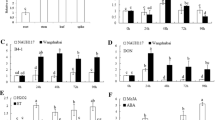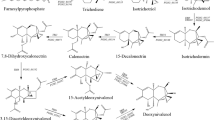Abstract
Fusarium head blight (FHB) is a devastating disease of small grain cereal crops caused by the necrotrophic pathogen Fusarium graminearum and Fusarium culmorum. These fungi produce the trichothecene mycotoxin deoxynivalenol (DON) and its derivatives, which enhance the disease development during their interactions with host plants. For the self-protection, the trichothecene producer Fusarium species have Tri101 encoding trichothecene 3-O-acetyltransferase. Although transgenic expression of Tri101 significantly reduced inhibitory action of DON on tobacco plants, there are several conflicting observations regarding the phytotoxicity of 3-acetyldeoxynivalenol (3-ADON) to cereal plants; 3-ADON was reported to be highly phytotoxic to wheat at low concentrations. To examine whether cereal plants show sufficient resistance to 3-ADON, we generated transgenic rice plants with stable expression and inheritance of Tri101. While root growth of wild-type rice plants was severely inhibited by DON in the medium, this fungal toxin was not phytotoxic to the transgenic lines that showed trichothecene 3-O-acetylation activity. This is the first report demonstrating the DON acetylase activity and DON-resistant phenotype of cereal plants expressing the fungal gene.





Similar content being viewed by others
References
Anzai H, Yoneyama K, Yamaguchi I (1989) Transgenic tobacco resistant to a bacterial disease by the detoxification of a pathogenic toxin. Mol Gen Genet 219:492–494
Baxter JA, Terhune SJ, Qureshi SA (1983) Use of chromotropic-acid for improved thin-layer chromatographic visualization of trichothecene mycotoxins. J Chromatogr 261:130–133
Bruins MBM, Karsai I, Schepers J, Snijders CHA (1993) Phytotoxicity of deoxynivalenol to wheat tissue with regard to in vitro selection for Fusarium head blight resistance. Plant Sci 94:195
Casas AM, Kononowicz AK, Zehr UB, Tomes DT, Axtell JD, Butler LG, Bressan RA, Hasegawa PM (1993) Transgenic sorghum plants via microprojectile bombardment. Proc Natl Acad Sci USA 90:11212–11216
Dahleen LS, McCormick SP (2001) Trichothecene toxin effects on barley callus and seedling growth. Cereal Res Commun 29:115–120
Desjardins AE, Hohn TM, McCormick SP (1993) Trichothecene biosynthesis in Fusarium species: chemistry, genetics, and significance. Microbiol Rev 57:595–604
Eudes F, Comeau A, Rioux S, Collin J (2000) Phytotoxicity of eight mycotoxins associated with Fusarium in wheat head blight. Can J Plant Pathol 22:286–292
Goswami RS, Kistler HC (2004) Heading for disaster: Fusarium graminearum on cereal crops. Mol Plant Pathol 5:515–525
Higa A, Kimura M, Mimori K, Ochiai-Fukuda T, Tokai T, Takahashi-Ando N, Nishiuchi T, Igawa T, Fujimura M, Hamamoto H, Usami R, Yamaguchi I (2003) Expression in cereal plants of genes that inactivate Fusarium mycotoxins. Biosci Biotechnol Biochem 67:914–918
Kimura M, Kaneko I, Komiyama M, Takatsuki A, Koshino H, Yoneyama K, Yamaguchi I (1998) Trichothecene 3-O-acetyltransferase protects both the producing organism and transformed yeast from related mycotoxins. Cloning and characterization of Tri101. J Biol Chem 273:1654–1661
McCormick SP, Alexander NJ, Trapp SE, Hohn TM (1999) Disruption of TRI101, the gene encoding trichothecene 3-O-acetyltransferase, from Fusarium sporotrichioides. Appl Environ Microbiol 65:5252–5256
McElroy D, Blowers AD, Jenes B, Wu R (1991) Construction of expression vectors based on the rice actin 1 (Act1) 5′ region for use in monocot transformation. Mol Gen Genet 231:150–160
Mitterbauer R, Poppenberger B, Raditschnig A, Lucyshyn D, Lemmens M, Glossl J, Adam G (2004) Toxin-dependent utilization of engineered ribosomal protein L3 limits trichothecene resistance in transgenic plants. Plant Biotechnol J 2:329–340
Muhitch MJ, McCormick SP, Alexander NJ, Hohn TM (2000) Transgenic expression of the TRI101 or PDR5 gene increases resistance of tobacco to the phytotoxic effects of the trichothecene 4,15-diacetoxyscirpenol. Plant Sci 157:201–207
Nishiuchi T, Masuda D, Nakashita H, Ichimura K, Shinozaki K, Yoshida S, Kimura M, Yamaguchi I, Yamaguchi K (2006) Fusarium phytotoxin trichothecenes have an elicitor-like activity in Arabidopsis thaliana, but the activity differed significantly among their molecular species. Mol Plant Microbe Interact 19:512–520
Ochiai-Fukuda T, Takahashi-Ando N, Ohsato S, Igawa T, Kadokura K, Hamamoto H, Nakasako M, Kudo T, Shibata T, Yamaguchi I, Kimura M (2006) A fluorescent antibiotic resistance marker for rapid production of transgenic rice plants. J Biotechnol 122:521–527
Okubara PA, Blechl AE, McCormick SP, Alexander NJ, Dill-Macky R, Hohn TM (2002) Engineering deoxynivalenol metabolism in wheat through the expression of a fungal trichothecene acetyltransferase gene. Theor Appl Genet 106:74–83
Pestka JJ, Zhou HR, Moon Y, Chung YJ (2004) Cellular and molecular mechanisms for immune modulation by deoxynivalenol and other trichothecenes: unraveling a paradox. Toxicol Lett 153:61–73
Rocha O, Ansari K, Doohan FM (2005) Effects of trichothecene mycotoxins on eukaryotic cells: a review. Food Addit Contam 22:369–378
Shifrin VI, Anderson P (1999) Trichothecene mycotoxins trigger a ribotoxic stress response that activates c-Jun N-terminal kinase and p38 mitogen-activated protein kinase and induces apoptosis. J Biol Chem 274:13985–13992
Tyc K, Konarska M, Gross HJ, Filipowicz W (1984) Multiple ribosome binding to the 5′-terminal leader sequence of tobacco mosaic virus RNA. Assembly of an 80S ribosome X mRNA complex at the AUU codon. Eur J Biochem 140:503–511
Wakita Y, Otani M, Iba K, Shimada T (1998) Co-integration, co-expression and co-segregation of an unlinked selectable marker gene and NtFAD3 gene in transgenic rice plants produced by particle bombardment. Genes Genet Syst 73:219–226
Wakulinski W (1989) Phytotoxicity of the secondary metabolites of fungi causing wheat head fusariosis (head blight). Acta Physiol Plant 11:301–306
Wang YZ, Miller JD (1988) Effects of Fusarium graminearum metabolites on wheat tissue in relation to Fusarium head blight resistance. J Phytopathol 122:118–125
Xie Y, Wu R (1989) Rice alcohol dehydrogenase genes: anaerobic induction, organ specific expression and characterization of cDNA clones. Plant Mol Biol 13:53–68
Zamir LO, Nikolakakis A, Devor KA, Sauriol F (1996) Biosynthesis of the trichothecene 3-acetyldeoxynivalenol. Is isotrichodermin a biosynthetic precursor? J Biol Chem 271:27353–27359
Acknowledgments
We thank Drs. D. McElroy and R. Wu for the gift of vectors with the rice Act1 promoter (McElroy et al. 1991). This research was supported by the Program for Promotion of Basic Research Activities for Innovative Biosciences (PROBRAIN).
Author information
Authors and Affiliations
Corresponding author
Additional information
Communicated by A. Atanassov
S. Ohsato and T. Ochiai-Fukuda should be considered as joint first authors.
Rights and permissions
About this article
Cite this article
Ohsato, S., Ochiai-Fukuda, T., Nishiuchi, T. et al. Transgenic rice plants expressing trichothecene 3-O-acetyltransferase show resistance to the Fusarium phytotoxin deoxynivalenol. Plant Cell Rep 26, 531–538 (2007). https://doi.org/10.1007/s00299-006-0251-1
Received:
Revised:
Accepted:
Published:
Issue Date:
DOI: https://doi.org/10.1007/s00299-006-0251-1




